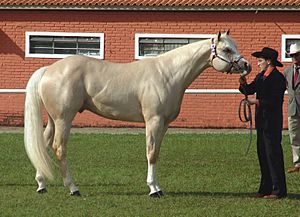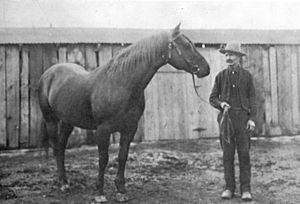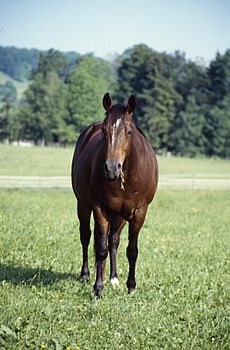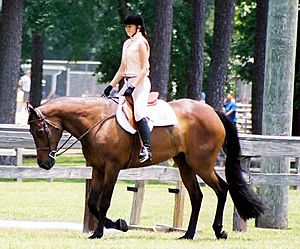American Quarter Horse facts for kids
The American Quarter Horse, often called the Quarter Horse, is a special type of horse from America. It's famous for being super fast over short distances. Its name comes from its amazing ability to win races that are a quarter-mile long or even shorter. Some of these horses can run as fast as 55 miles per hour (88.5 km/h)! People started developing this breed way back in the 1600s.
Today, the American Quarter Horse is the most popular horse breed in the United States. The American Quarter Horse Association (AQHA) is the biggest horse registry in the world. In 2014, nearly 3 million American Quarter Horses were registered with them. These horses are well-known for racing and for their skills in rodeos, horse shows, and as working ranch horses.
The American Quarter Horse has a strong, compact body. This shape helps them make quick, tricky moves. They are great at reining, cutting, and barrel racing. These are all western riding events, especially those that involve working with cattle. Quarter Horses are also used in English sports, driving, show jumping, and dressage. They take part in many other horse activities too.
Contents
History of the Quarter Horse Breed
Early Days in the Colonies
In the 1600s, on the East Coast of what is now the United States, people started breeding horses. They mixed Thoroughbred horses imported from England with local "native" horses.
One very famous early Thoroughbred was named Janus. He was born in 1746 and brought to colonial Virginia in 1756. Horses like Janus helped create the colonial "Quarter Horse." This new horse was small, tough, and very fast. It was used for farm work during the week and for racing on weekends.
As flat racing became popular, the Quarter Horse became even more famous. They were perfect for short races on straight roads or open fields. These horses often beat Thoroughbreds in sprint races. Many colonial Quarter Horses were even included in the first American horse stud books. This started a long connection between Thoroughbreds and what we now call the "Quarter Horse." They were named for the quarter-mile race distance where they were champions.
Moving Westward
In the 1800s, pioneers traveled west across America. They needed strong, willing horses for their journey. On the Great Plains, settlers found horses that came from Spanish horses. These were brought by explorers like Hernán Cortés to what is now the Southwestern United States and Mexico.
The horses in the West included wild herds called Mustangs. There were also horses tamed by Native Americans, like the Comanche and Nez Perce tribes. When the colonial Quarter Horse was bred with these western horses, the new horses had a special "cow sense." This meant they had a natural talent for working with cattle. This made them very popular with cattlemen on ranches.
Becoming a Special Breed
Some of the first important horses that helped create the Quarter Horse breed include Steel Dust (born 1843) and Peter McCue (born 1895). Another early horse was Copperbottom (born 1828). His family line goes back to the Byerley Turk, an important horse for the Thoroughbred breed.
The main job of ranch horses in the American West was working with cattle. Even after cars were invented, horses were still needed to handle livestock. Big Texas cattle ranches, like the King Ranch, helped a lot in developing the modern Quarter Horse. The skills cowboys and their horses used became the basis for the rodeo. Rodeos started as friendly contests between cowboys and grew into big events across the West. Even today, the Quarter Horse is the best at events that need speed and the ability to work with cattle.
Sprint races were also fun weekend entertainment. Racing became a way for breeders to make money. So, more Thoroughbred blood was added to the developing American Quarter Horse breed. The American Quarter Horse also got good traits from Arabian, Morgan, and even Standardbred horses.
In 1940, the American Quarter Horse Association (AQHA) was formed. It was started by horsemen and ranchers from the Southwestern United States. They wanted to keep track of their ranch horses' family trees. The first horse to get a registration number, P-1, was Wimpy. He was a descendant of a famous horse from the King Ranch. Other important early horses registered by the AQHA included Joe Reed P-3 and Oklahoma Star P-6. The Thoroughbred race horse Three Bars is also known as one of the most important horses for the Quarter Horse breed.
"Appendix" and "Foundation" Horses
The AQHA still allows some Thoroughbred horses to be added to its registry. An "Appendix" American Quarter Horse is usually a mix of a registered Thoroughbred and a Quarter Horse. These horses are listed in a special "appendix" part of the AQHA's studbook.
Appendix horses can compete in shows. If they do well and meet certain body standards, they can earn their way into the main studbook. This means their future babies can be fully registered Quarter Horses.
Because Thoroughbreds are still added to the breed, the American Quarter Horse is always changing. Some breeders worry that adding too much Thoroughbred blood might change the breed's original look and skills. Some prefer the older style of Quarter Horse. They have even started their own groups to register "Foundation" Quarter Horses, which are closer to the original type.
American Quarter Horses Today
Today, the American Quarter Horse is best known as a show horse, race horse, and a champion in reining and cutting. They are also great rodeo competitors, ranch horses, and all-around family horses. Quarter Horses are often used in rodeo events like barrel racing, calf roping, and team roping.
This breed is not just good for western riding and working with cattle. Many race tracks have Quarter Horse races where horses can win millions of dollars. Quarter Horses have also been trained for dressage and show jumping. They are also popular for fun trail riding and are even used by mounted police units.
The American Quarter Horse is popular all over the world. Countries like Germany and Italy have imported many Quarter Horses. After the American Quarter Horse Association (which includes horses from Canada), the second largest group of Quarter Horses is in Brazil, followed by Australia. The breed is also becoming very popular in the UK. With reining becoming a global sport and part of the World Equestrian Games, more people around the world are interested in Quarter Horses. The American Quarter Horse is still the most popular breed in the United States. The AQHA is the largest horse registry globally, with almost 3 million Quarter Horses registered in 2014.
What Makes a Quarter Horse Special?
The Quarter Horse has a small, refined head with a straight nose. They have a strong, muscular body with a wide chest and powerful, rounded back legs. They usually stand between 14 and 16 hands tall. Some horses bred for halter shows or English riding might be as tall as 17 hands.
There are two main body types: the stock type and the hunter or racing type. The stock horse type is shorter, more compact, and very muscular, but still quick. The racing and hunter type Quarter Horses are taller and have smoother muscles. They look more like a Thoroughbred.
Quarter Horses come in almost every color. The most common color is sorrel, which is a reddish-brown. Other colors include bay, black, palomino, gray, and many more. In the past, horses with spotted patterns were not allowed to be registered. But now, with DNA testing, the registry accepts all colors as long as both parents are registered.
Stock Type Horses
A stock horse is a type of horse that is great at working with livestock, especially cattle. Reining and cutting horses are smaller. They have quick, agile movements and very powerful back legs. Western pleasure show horses are often a bit taller. They have slower, smoother movements and a slightly more level back. However, they still have the strong back legs that are a key feature of the Quarter Horse.
Halter Type Horses
Horses shown in Halter competitions are judged on their looks. These horses are larger and look very heavily muscled. They still have small heads with wide jaws and refined muzzles. There's some discussion among owners and vets about how healthy this extreme muscle mass is for the horse. This is especially true for halter horses that can weigh over 1200 pounds. There are worries about the weight on their bones. This massive build is also linked to a genetic condition called hyperkalemic periodic paralysis (HYPP) in horses from the stallion Impressive.
Racing and Hunter Type Horses
Quarter Horse race horses are bred to sprint short distances, from 220 to 870 yards. They have long legs and are leaner than stock type horses. But they still have muscular back legs and powerful legs. Quarter Horses mainly race against other Quarter Horses. Their sprinting ability has earned them the nickname, "the world's fastest athlete." The show hunter type is slimmer and looks even more like a Thoroughbred. They often have more Thoroughbred blood in their family tree. They compete in hunter/jumper classes at horse shows.
Genetic Health Concerns
There are a few genetic conditions that Quarter Horse breeders pay attention to:
- Hyperkalemic periodic paralysis (HYPP): This condition is caused by a gene linked to the stallion Impressive. Horses with HYPP can have uncontrolled muscle twitching and weakness. If a horse has this gene, it can pass it on to its babies. There is a DNA test for HYPP, and the AQHA requires it. Since 2007, the AQHA does not register horses that have two copies of this gene. Horses with one copy can still be registered, but this is being discussed. All Quarter Horses born after 2007 that are related to Impressive must have a note about HYPP on their registration papers.
- Malignant hyperthermia: This is another genetic condition. It can be triggered by overwork, stress, or certain medicines used during surgery.
- Hereditary Equine Regional Dermal Asthenia (HERDA): This condition affects the skin. It's caused by a recessive gene, meaning both parents must carry the gene for a foal to get it. When a horse has HERDA, its skin layers don't hold together well. If the horse is ridden or gets a skin injury, the outer layer can split or tear. This rarely heals without scars. Most horses with HERDA are put down between two and four years old for their comfort. There is a DNA test for HERDA.
- Glycogen Branching Enzyme Deficiency (GBED): This is a genetic disease where the horse is missing an enzyme. This enzyme is needed to store energy (glycogen). Without it, the horse's heart and muscles can't work properly, which leads to death quickly. Foals get this disease if both parents carry the gene. The stallion King P-234 has been linked to this disease. There is a DNA test for this gene.
- Equine polysaccharide storage myopathy (PSSM): This is a muscle condition that can cause horses to "tie up" (muscle stiffness and pain). It's also related to how horses store energy. It's seen in some Quarter Horses and can sometimes be managed with a special low-starch diet. Genetic testing is advised before breeding.
- Lethal White Syndrome: Although Quarter Horses with certain spotted patterns were not allowed to be registered for many years, the gene for these markings is recessive. This means it can still show up in Quarter Horse foals. It's believed that some Quarter Horses might carry the gene for Lethal White Syndrome. There is a DNA test for this condition.
- Cleft Palate: This is a birth defect where the roof of the mouth doesn't form completely. It's very rare and can be caused by genetics, hormones, or other factors. Surgery to fix it doesn't have a high success rate. Quarter Horses seem to have more research on this defect, and it appears more often in them based on studies. Signs of a cleft palate can include lifting the head high to eat or drinking with the head low.
See also
 In Spanish: Cuarto de Milla para niños
In Spanish: Cuarto de Milla para niños






